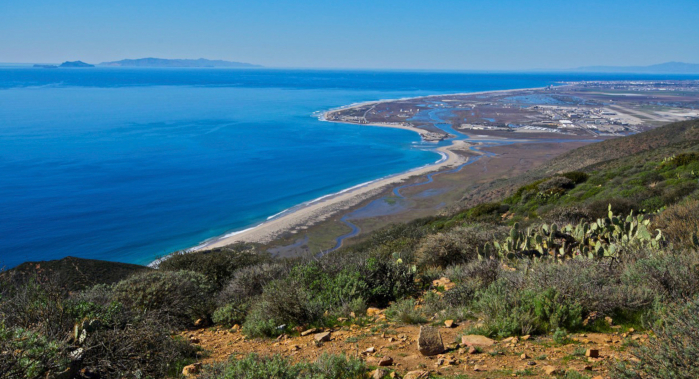With California’s population on track to reach 50 million people, the demand for energy, water, and land will continue to grow. Climate change will compound the strains on society and the environment. Most of this population growth will be centered in larger cities that are already struggling to maintain aging transportation and water infrastructure.
But nature can play an important role in the redevelopment of these systems. Wetlands treat storm water, oyster reefs buffer storm surges, and shade trees reduce heat, providing the benefits of traditional infrastructure while adding scenery and wildlife habitat.
Conservancy scientists are demonstrating how society can minimize trade-offs between development and conservation through innovative regional planning. And by showing what nature can do for cities–and what cities can do for nature–we can develop models for improving the quality of urban life, with broad application on an urbanizing planet.


Michael J Clifford, Peter Gower, Tanya Anderson, Jaina Moan, Mickey Hazelwood, Sophie S Parker, Laurel Saito
Dramatic changes to the transportation and energy sectors are required to reduce greenhouse gas emissions and meet the goal of keeping global average temperatures from rising. The authors discuss how…The Nature Conservancy with Willis Towers Watson, Sarah Heard
California has the highest wildfire risk in the US, and climate change will continue to exacerbate the risk, at least in the foreseeable future. As a result, California is facing an insurance crisis,…Trish Smith, Cheryl Brehme, Jill Carpenter, Nancy Frost, Megan Jennings, Barbara Kus, Scott Quinnell, Spring Strahm, T. Winston Vickers
The Nature Conservancy and the California Department of Transportation are planning 3 wildlife crossing infrastructure projects along a 3-mile stretch of Interstate 15 (I-15) in the Santa Ana-Palomar…Michele Romolini, Sophie S. Parker, Gregory B. Pauly, Eric M. Wood
This editorial introduces a group of 11 articles published as part of an organized research topic in the Urban Greening section of the journal Frontiers in Sustainable Cities. In contrast with the…Kristina Kreter, Shona Ganguly, Rowan Roderick-Jones, and Kelsey Jessup
New strategies to address urban runoff management with nature-based approaches offer promising solutions to alleviating climate change impacts—like urban heat, water shortages, and…Taylor-Burns, R., Heard, S., Beck, M. W.
There is growing evidence for the beneficial role that wetlands can play in reducing flood risk, but in many urban estuaries, coastal development has resulted in dramatic habitat loss and…Grace C. Wu, Ryan A. Jones, Emily Leslie, James H. Williams, Andrew Pascale, Erica Brand, Sophie Parker, Brian Cohen, Joseph Fargione, Julia Souder, Maya Batres, Mary G. Gleason, Michael H. Schindel, Charlotte K. Stanley
This paper presents the results of the Power of Place-West project. The authors combined energy modeling with ecosystem and wildlife habitat data to determine the costs and impacts associated with…Maura Palacios Mejia, Connie Rojas, Emily Curd, Mark Renshaw, Kiumars Edalati, Beverly Shih, Nitin Vincent, Meixi Lin, Peggy Nguyen, Robert Wayne, Kelsey Jessup, Sophie Parker
This paper presents results from a study conducted at TNC’s multi-benefit stormwater management and habitat enhancement project site adjacent to the Los Angeles River. Due to a history of…Sophie S. Parker, Linnea S. Hall, Mary J. Whitfield, Laura Riege, Kathryn R. Selm, René Corado
This paper presents results from a field-based study that can be used to benefit songbirds in riverside habitats like those found along the Santa Clara River in Ventura County, California. Songbirds…Tamaki Bieri, Alyssa Mann
Kelsey Jessup, Sophie S. Parker, John M. Randall, Brian S. Cohen, Rowan Roderick-Jones, Shona Ganguly, Jill Sourial
This paper presents results from Planting Stormwater Solutions, part of TNC’s Urban Conservation work in Los Angeles. The authors develop a methodology to prioritize siting of vegetated…Environmental Science Associates (ESA) for The Nature Conservancy and Naval Base Ventura County
Charlotte Stanley, Alyssa Mann, Walter Heady
The United States operates thousands of military installations in the U.S. and worldwide, worth about $1.2 trillion. These facilities are where personnel train and test weaponry, with…Walter Heady, Alyssa Mann, Stacey Solie, Bob Battalio, James Jackson, Kendall Lousen, and Bob Barnes
The U.S. Congress and the Department of Defense (DoD) have determined that climate change is a threat to national security and have required military installations to develop plans to improve the…Alyssa Mann, Walter Heady, Charlotte Stanley
TNC and the United States Navy partnered together to prepare for the impacts of climate change on Naval Base Ventura County (NBVC), Point Mugu in California. NBVC is a critical and strategic asset of…Alyssa Mann, Walter Heady, Charlotte Stanley
Robert I. McDonald, Tanushree Biswas, Cedilla Sachar, Ian Housman, Timothy M. Boucher, Deborah Balk, David Nowak, Erica Spotswood, Charlotte K. Stanley, Stefan Leyk
Urban tree cover provides benefits to human health and well-being, but it is often inequitably distributed. In this study, researchers Google Earth Engine (GEE) and an automated machine learning…Brian Cohen, Kelsey Jessup, Sophie Parker, John Randall, Jill Sourial
Cities across Southern California are investing in new infrastructure to address the challenges of stormwater management. We promote the use of nature-based solutions to ensure projects both treat…Ethan Inlander, Katie Andrews, Contributors: Jennifer Chin, Sue Pollock, Mike McFadden, Scott Hardage, Scott Butterfield, Tod Rubin
With this publication, TNC in California marks a major shift in its approach to conservation easement monitoring. At the crossroads of conservation, stewardship and technology lies remote property…